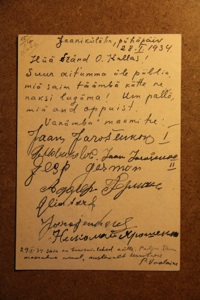Ludzī kīļ : Orthography and Pronunciation

Lutsi pronuniciation and the practical Lutsi orthography
This section describes the practical orthography I have designed for writing Lutsi. Vowel length, as in Latvian and Latgalian, is marked with a macron (-) written over the lengthened vowel (e.g. ā, ȳ, ǖ). A long consonant is written by doubling that consonant (e.g. tt, kk, ļļ).
As in Latvian and Latgalian, palatalized consonants are written with a palatalization mark (,) under the palatalized consonant (for example, nāņe ‘woman’, maŗā ‘berry’, taļvīne ‘wintery’). In non-initial syllables, consonants preceding i, are palatalized in general and therefore palatalization is not marked for consonants in that position. So, pinī ‘dog’ is pronounced as if it were written piņī. This is done just to keep the Lutsi writing system clear of too many diacritical marks.
It should be noted that for some Lutsi speakers, palatalization also occurred sporadically for consonants preceding other front vowels or even front vowels in general (in Lutsi, these are the long and short forms of i, e, ä, ö, ü).
The vowel ä is pronounced like ‘a’ in ‘cat’. The vowel y is usually pronounced like Estonian õ. The vowels ö and ü are pronounced like ö and ü in Estonian or German. The consonants š and ž are pronounced like ‘sh’ in ‘shoe’ and ‘z’ in ‘azure’, respectively, while tš is pronounced like ‘ch’ in ‘church’. The consonant q represents a glottal stop. In English, a glottal stop is the short break between the two syllables in “uh oh”.
The consonants b, d, f, g, h, k, m, n, p, s, t, v, z are all pronounced as in English. The consonant g is always pronounced as ‘g’ in ‘got’.
The consonant l is velarized when it occurs before central and back vowels (a, o, u, y). Variations on velarized l or “hard l” occur in Russian and Latvian and especially the Russian l can serve as a guide for how to pronounce the Lutsi l in this position.
Word stress is not marked on words. As in other Finnic languages and also in Latvian, primary stress in Lutsi is generally on the first syllable. An important exception is negated verbs. In these verbs (e.g. ole-eiq ‘is not’ and anna-as ‘did not give’) the negative enclitic is stressed rather than the first syllable of the verb.

A short note written in Lutsi and sent to Oskar Kallas in London by Voolaine and Lutsis from the village of Lielie Tjapši (Jānikülä) in 1934.
The History of writing Lutsi
Lutsi has never been a written language. Linguists have recorded it using phonetic transcription and in some individual cases there are records of researcher Paulopriit Voolaine seemingly attempting to encourage the practice of writing Lutsi among its speakers in the years before World War II. There are at least several letters written in Lutsi by Voolaine himself or along with a number of Lutsi community members to Oskar Kallas, the first researcher to study the Lutsis, who, during Estonia’s first independence period was Estonia’s ambassador to the United Kingdom and several other countries. During those same pre-war years, the Livonians, another of Latvia’s Finnic minority nations, were publishing a newspaper and books in Livonian. Nothing of the kind happened for the Lutsis during that time.
One of the goals of my current research is to write a primer for learning about Lutsi. In order to write this kind of a book, it was necessary to first create a practical orthography -- a writing system that could be read and used with ease by readers who were not professional linguists. Also, as there are no living fluent speakers of Lutsi today,I wanted to create a written form for Lutsi that conveyed
the pronunciation of Lutsi as clearly as possible. This is so that readers could pick up the primer and even in the absence of Lutsi speakers to consult could sound out each Lutsi word with reasonable accuracy. The Lutsi writing system is based on the orthographies of Latvian and Latgalian. The orthographies of these languages are particularly well-suited for writing Lutsi and, in addition, all Lutsi descendants today speak one or both of these languages. The writing of some sounds and other features had to either be invented or added to the Lutsi writing system from the current South Estonian (Võro-Seto) writing system in use in Estonia.


